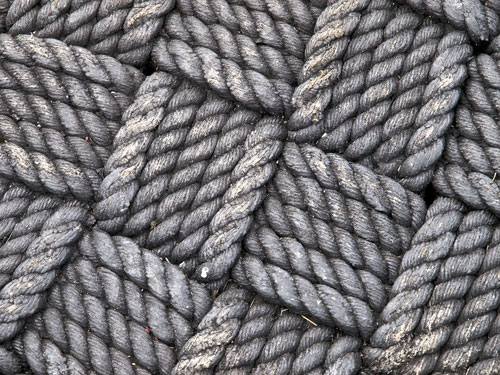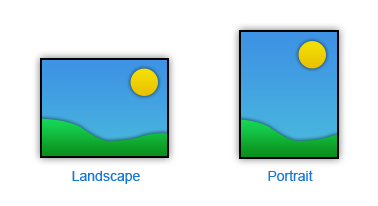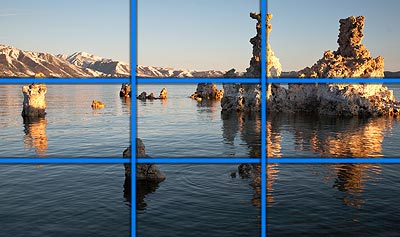Rule of thirds
the rule of thirds is a technique capturing the main focus in other parts of the image and not the center, this technique breaks the image down into thirds vertically and horizontally so the image it cut up into 9 different parts, the main aims is to have something of interest in each segment of the picture. It can be used when the background is simple or is noise the main effect is to get the user to interact with the picture more that they would with just a normal image where the main focus is sat in the middle of the photo.
the rule of thirds is a technique capturing the main focus in other parts of the image and not the center, this technique breaks the image down into thirds vertically and horizontally so the image it cut up into 9 different parts, the main aims is to have something of interest in each segment of the picture. It can be used when the background is simple or is noise the main effect is to get the user to interact with the picture more that they would with just a normal image where the main focus is sat in the middle of the photo.
Leading lines
leading lines in a photo are used to guide the viewer’s eye into the photo and into a certain point the easiest way to put this is if the main subject is a road or walkway. Usually this leading line will start from the bottom of the photo and carrier on to a main subject which will be near the top of the picture. Not just roads and paths can be used as leading lines other things as long as they are leading the viewer’s eyes somewhere can be used as well. This is a good technique to use to get the viewer interacting with the photo.
leading lines in a photo are used to guide the viewer’s eye into the photo and into a certain point the easiest way to put this is if the main subject is a road or walkway. Usually this leading line will start from the bottom of the photo and carrier on to a main subject which will be near the top of the picture. Not just roads and paths can be used as leading lines other things as long as they are leading the viewer’s eyes somewhere can be used as well. This is a good technique to use to get the viewer interacting with the photo.

Perspective
In photography there are many different types of perspective such as Height, Linear, Aerial, Diminishing Size and Forced, all are important and all are used for a specific thing.
In photography there are many different types of perspective such as Height, Linear, Aerial, Diminishing Size and Forced, all are important and all are used for a specific thing.
Height Perspective
height perspective is used to show the height of the main focus or to emphasize the main focus and make it look much bigger than it actually is, things are made to look bigger because it creates the thought of power. To get height perspective the photograph is usually taken at a low angle with the camera pointing up at the main focus.
height perspective is used to show the height of the main focus or to emphasize the main focus and make it look much bigger than it actually is, things are made to look bigger because it creates the thought of power. To get height perspective the photograph is usually taken at a low angle with the camera pointing up at the main focus.
Linear
Linear is a way to show the depth of a photo, the photographer will usually
do this by using the leading line technique and will follow lines from the
foreground of the picture into the background of the picture. To do this
perspective the photo can be taken at any angle as long as it’s following lines
into the photo.

Aerial
An aerial shot is used by the photographer usually to emphasize the smallness of things and to capture a larger area space. These type of shots are usually taken with the camera facing down from high up. A person who’s is famous for his aerial shots is French photographer Yann Arhtus-Bertrand he like other photographers used aerial shots to capture the largess and the vastness of the world.
An aerial shot is used by the photographer usually to emphasize the smallness of things and to capture a larger area space. These type of shots are usually taken with the camera facing down from high up. A person who’s is famous for his aerial shots is French photographer Yann Arhtus-Bertrand he like other photographers used aerial shots to capture the largess and the vastness of the world.

Diminishing Size
Diminishing size technique can be used similar to
leading lines, it can be used to draw the viewer in and lead there eye to
something significant in the picture. Photographers usually use this technique
to show the length of something and sometimes used to exaggerate the length of
something to get things to diminish in size it is usually angled sideways on so
it captures a big size of the focus in the foreground and a little size of the
focus in the background. Diminishing size can be used horizontally and
vertically as long as you have a line or edge to follow.

Forced
Forced Photography is a technique use to
manipulate photos for example when people pretend to lean on the leaning tower
of Pisa or when people pretend to hold up the sun. Usually this is done by
getting the person to stand close to the lens of the camera, do a certain pose
or hand gesture depending on the main subject and they photographer will line
it up to make it look like everything is one.


Viewpoint
In Photography there are many different viewpoints and camera angles for example there is, Landscape, portrait and viewpoints of nature, architecture and crowds and people. The photographer will use different viewpoints and angle depending on what they are taking a photo off and depending on what message they are trying to get across. For example if they are trying to capture a person’s emotion who is sad they would usually take a portrait shot from high to low, capturing as much emotion as possible from the portrait shot and creating an angle which makes the person look small, helpless and scarred.
In Photography there are many different viewpoints and camera angles for example there is, Landscape, portrait and viewpoints of nature, architecture and crowds and people. The photographer will use different viewpoints and angle depending on what they are taking a photo off and depending on what message they are trying to get across. For example if they are trying to capture a person’s emotion who is sad they would usually take a portrait shot from high to low, capturing as much emotion as possible from the portrait shot and creating an angle which makes the person look small, helpless and scarred.

Symmetry and Asymmetry
Symmetrical photos in
photography are very popular as they are very aesthetically pleasing to
viewers, a photo that uses symmetry is a photo that is you were to put a line
down the middle of the picture it will look the same on both sides a
photographer who is famous for symmetrical pictures is Jim Zuckerman. Although
symmetrical pictures are popular the most popular are Asymmetrical pictures
because when the photographer is taking a picture there will be a main focus
and when the main focus is in the center of the photo usually both side of the
focus won’t be symmetrical. The main type of photos you ‘ll find Asymmetry is
ones which use the rule of thirds as there has to be something happening in
each part of the photo.


Patterns/textures
patters and textures in photos are like bright colours, leading lines and are sometimes even as important as the main focus. Usually textures in photos are used to make the viewer interact with the photo rather than just look at a photo it makes the viewer investigate and look everywhere. In some occasions some details can be used as other things for example if a piece of wood has a grain on it, it can be used as a leading line. A photographer who was one of the first and who is famous for textured and patterned photographs is Edward Weston.
patters and textures in photos are like bright colours, leading lines and are sometimes even as important as the main focus. Usually textures in photos are used to make the viewer interact with the photo rather than just look at a photo it makes the viewer investigate and look everywhere. In some occasions some details can be used as other things for example if a piece of wood has a grain on it, it can be used as a leading line. A photographer who was one of the first and who is famous for textured and patterned photographs is Edward Weston.


Solids and silhouettes
solid photos and silhouettes are photos where the main focus is a shadow against the background of the photo, usually to capture a silhouette the photo of the main focus will be take against a bright background for example a sunset or if in a studio a bright light. Capturing a solid or silhouette picture doesn’t just depend on the background lighting it can also be created by changing the camera ISO, Shutter speed and aperture for example the lower the aperture and faster the shutter speed the more chance you’ll get of a solid/silhouette.
solid photos and silhouettes are photos where the main focus is a shadow against the background of the photo, usually to capture a silhouette the photo of the main focus will be take against a bright background for example a sunset or if in a studio a bright light. Capturing a solid or silhouette picture doesn’t just depend on the background lighting it can also be created by changing the camera ISO, Shutter speed and aperture for example the lower the aperture and faster the shutter speed the more chance you’ll get of a solid/silhouette.

Depth of field
there are two types of depth of field, there is shallow depth of field and large depth of field. Shallow depth of field is when the main focus is in focus and the background is blurred out. This is because if the main focus is in focus and the background is blurred out they viewer is made to focus on the main thing in the photo, sometimes the photographer will capture a path or a road which will start of in focus and will fade out and blur out this world like leading lines and makes the viewer interact with the picture, it also create a scene of wonder for the viewer and will make them think about what is past the blurriness. To capture depth of field you will want the aperture to be low. Large depth of field is where the photographer will capture the whole of the picture in detail, a photographer will usually use this when they are capturing a wide shot of a lot of things for example a landscape shot of fields. This is because the main focus of the photo is the whole things and using a large depth of field the viewer will be able to see everything clearly. To capture the whole image or as much as you can you will want the aperture higher.
there are two types of depth of field, there is shallow depth of field and large depth of field. Shallow depth of field is when the main focus is in focus and the background is blurred out. This is because if the main focus is in focus and the background is blurred out they viewer is made to focus on the main thing in the photo, sometimes the photographer will capture a path or a road which will start of in focus and will fade out and blur out this world like leading lines and makes the viewer interact with the picture, it also create a scene of wonder for the viewer and will make them think about what is past the blurriness. To capture depth of field you will want the aperture to be low. Large depth of field is where the photographer will capture the whole of the picture in detail, a photographer will usually use this when they are capturing a wide shot of a lot of things for example a landscape shot of fields. This is because the main focus of the photo is the whole things and using a large depth of field the viewer will be able to see everything clearly. To capture the whole image or as much as you can you will want the aperture higher.

Cropping
the main reasons photographers crop pictures are to
increase the viewer’s focus on the main focus
by increasing the size of the main focus, another reason the
photographers using cropping is because they have taken a picture and wasted a
lot of it by captures to many things that aren’t relevant for example a blurred
out background. Sometimes cropping can be bad as well because a photographer
can crop a photo and make it look too crowded by cropping too much of the
background and make the main image to large.

Orientation (landscape/portrait)
the orientation is very important in photography and really does depend on what the photographers main subject in for example if they are going to capture a photo of a sunset they will usually capture it with a landscape shot and if they were going to take a photo of someone they will usually use portrait, although this isn’t a rule and both types of shots can be used for the same thing, for example if it’s a photo of a sunset but you want to capture the details of the ground and sunset you can take a portrait shot. Or if you want to capture the main image more against a background it would be better to use portrait.
the orientation is very important in photography and really does depend on what the photographers main subject in for example if they are going to capture a photo of a sunset they will usually capture it with a landscape shot and if they were going to take a photo of someone they will usually use portrait, although this isn’t a rule and both types of shots can be used for the same thing, for example if it’s a photo of a sunset but you want to capture the details of the ground and sunset you can take a portrait shot. Or if you want to capture the main image more against a background it would be better to use portrait.

Triangles
in photography triangles are used in many different ways for example the most common triangle you will see is a implied triangle which is usually found in architectural photography, this is where the base of the triangle is found at the bottom of the photo and the top of the triangle is found at the top of the photo. Another triangle used is converging triangles which is used like leading lines they will start in the foreground of the photo and go into the background drawing the views eye in. there is also the three figure shot which puts 3 main focuses on each point of the triangle, this technique uses the rules of thirds.
in photography triangles are used in many different ways for example the most common triangle you will see is a implied triangle which is usually found in architectural photography, this is where the base of the triangle is found at the bottom of the photo and the top of the triangle is found at the top of the photo. Another triangle used is converging triangles which is used like leading lines they will start in the foreground of the photo and go into the background drawing the views eye in. there is also the three figure shot which puts 3 main focuses on each point of the triangle, this technique uses the rules of thirds.

My Examples
-Rule of thirds
-Leading lines
Perspective
-Height perspective
-Linear
-Aerial
-Diminishing Size
-Forced
Viewpoint
-Symmetry & Asymmetry
-Patterns/textures
-Solids and Silhouettes
-Depth of Field
-Cropping
-Landscape/Portrait
-Triangles
-Leading lines
Perspective
-Height perspective
-Linear
-Aerial
-Diminishing Size
-Forced
Viewpoint
-Symmetry & Asymmetry
-Patterns/textures
-Solids and Silhouettes
-Depth of Field
-Cropping
-Landscape/Portrait
-Triangles




















































No comments:
Post a Comment